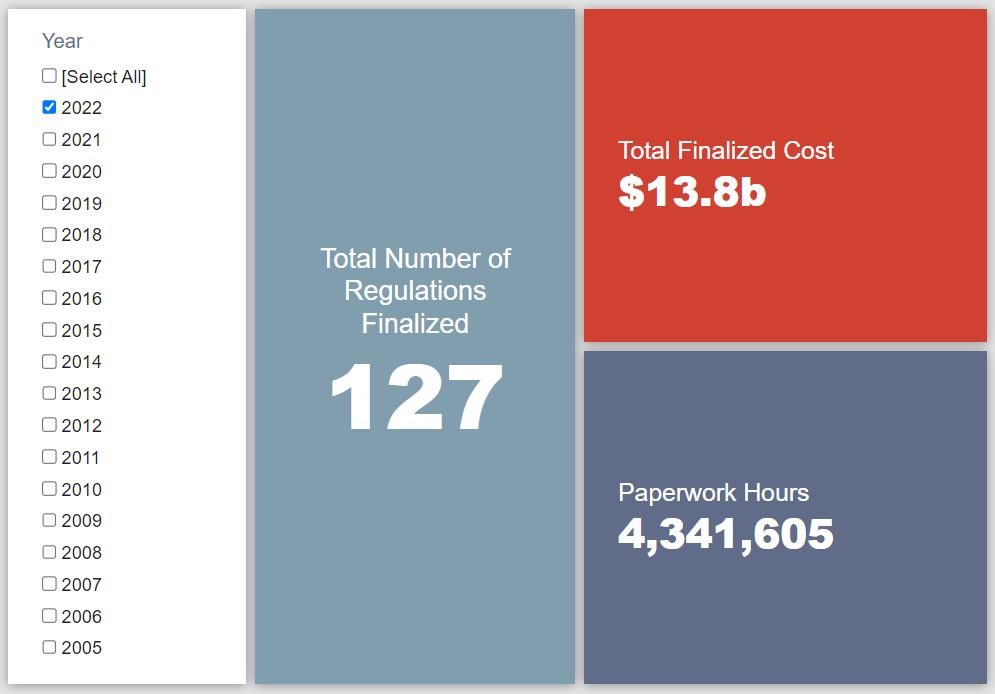Week in Regulation
July 11, 2022
DOE Brings the Heat
Outside of one proposed rule, the holiday-shortened week was largely a muted one. Across 11 rulemakings with some measurable economic impact, most failed to have an effect beyond the tens of millions of dollars range. A Department of Energy (DOE) proposal regarding efficiency standards for consumer furnace units provided almost the entirety of the week’s cost total. Across all rulemakings, agencies published $4 billion in total net costs and added 250,370 annual paperwork burden hours.
REGULATORY TOPLINES
- Proposed Rules: 23
- Final Rules: 47
- 2022 Total Pages: 40,963
- 2022 Final Rule Costs: $13.8 billion
- 2022 Proposed Rule Costs: $82.3 billion
NOTABLE REGULATORY ACTIONS
The most significant rulemaking of the week was DOE’s proposed rule regarding “Energy Conservation Program: Energy Conservation Standards for Consumer Furnaces.” In particular, the proposed rule seeks to update the standards for “Non-Weatherized Gas Furnaces and Mobile Home Gas Furnaces.” The proposal continues a recent trend and marks yet another energy efficiency rulemaking that crosses the billion-dollar threshold. DOE estimates that the “Consumer Incremental Product Costs” increases for such furnaces could add up to $4 billion over a 30-year period.
TRACKING THE ADMINISTRATIONS
As we have already seen from executive orders and memos, the Biden Administration will surely provide plenty of contrasts with the Trump Administration on the regulatory front. And while there is a general expectation that the current administration will seek to broadly restore Obama-esque regulatory actions, there will also be areas where it charts its own course. Since the AAF RegRodeo data extend back to 2005, it is possible to provide weekly updates on how the top-level trends of President Biden’s regulatory record track with those of his two most recent predecessors. The following table provides the cumulative totals of final rules containing some quantified economic impact from each administration through this point in their respective terms.
![]()
As noted above, last week’s major action came on the proposed rule side. As such, there was limited movement in the Biden Administration’s final rule tallies; costs increased by a grand total of $17.4 million while annual paperwork ticked up by just over 100,000 hours. The other two administrations’ rulemakings were also relatively modest, albeit in opposite directions. For the Trump Administration – thanks primarily to a Department of Education rule – costs and paperwork declined by $18.2 million and 152,000 hours, respectively. The Obama-era totals rose by $38.4 million and 385,000 hours with a defense acquisition rule providing the bulk of both those increases.
THIS WEEK’S REGULATORY PICTURE
This week, a federal court tosses three Trump-era Endangered Species Act (ESA) rules.
Source: “Wildlife” by Lucie Sa_Vi
On July 5, a judge on the U.S. District Court for the Northern District of California vacated three rules promulgated in August 2019 by the Trump Administration dealing with the ESA. The first allowed the federal agencies that implement the ESA, the Fish and Wildlife Service and the National Marine Fisheries Service (the Services), to consider economic impacts when making listing decisions and critical habitat designations. The second removed a provision that automatically protected species designated as threatened prior to their potential listing as endangered. The third amended federal regulations regarding how agencies cooperate with regard to the ESA.
In tandem, the Trump Administration’s rules trimmed back the effective coverage of the ESA by making the Services consider additional factors in how they list species and designate protected areas. They also removed certain prohibitions on takes, or kills or removals, of plants and animals designated as threatened. The changes were intended to limit possible adverse economic impacts from overly protective listings and habitat areas designations, which some viewed as tools abused by environmental groups to prevent development.
Environmental groups challenged the rules on procedural grounds, arguing that the Services failed to properly assess potential harms and impacts to the environment and that changes were made to the final rule that were not available for public comment. The rules’ fate was sealed with the inauguration of the Biden Administration, which immediately indicated it intended to review the rules.
With the plaintiffs and federal government of like mind on the matter, a federal judge remanded the issue back to the Services and vacated the 2019 rules. The decision gives the Biden Administration a blank slate with which to revise ESA protections if it chooses and prevents it from having to go through the regulatory process to remove the Trump-era rules.
TOTAL BURDENS
Since January 1, the federal government has published $96.1 billion in total net costs (with $13.8 billion in new costs from finalized rules) and 71.1 million hours of net annual paperwork burden increases (with 4.3 million hours in increases from final rules).













